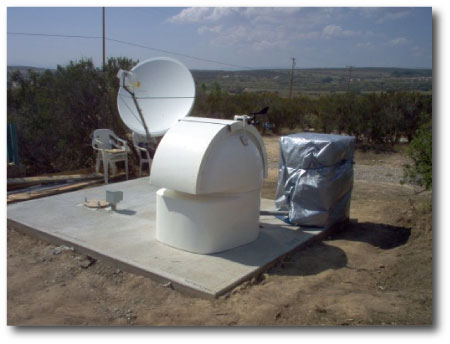
Last week, we posted Kent Richardson’s light-curve for the nearby red dwarf star GL 581 (Sloan DSS image pictured above). Kent’s photometry was taken during a predicted transit window, and along with data from David Blank and collaborators in Australia, it contributed to rule out the possibility of planetary transits by the red dwarf’s steamy Neptune-mass companion.
Like Marlon Brando in On the Waterfront, GL 581 b “could’ve been a contender”, and connoisseurs of the might-have-been should be sure to read the oklo posts [1,2] that talk about what this planet would have taught us if only it was transiting…
No need to despair, however. There’s a whole slew of candidates on the transitsearch.org candidates list which remain entirely unexplored.
Kent obtained his data with a robotic telescope located at the San Diego Astronomy Association’s dark site at Tierra Del Sol, California, approximately 60 miles east of downtown San Diego:

Kent reports,
There are three major components of the installation: The dome and telescope, the data cabinet, and the satellite antenna. The details of each are as follows:
Dome
Robo Dome by Technical Inovations, Inc.
Meade 8″ LX-200 Classic f/10
Meade f3.3 Focal reducer
SBIG ST-7 CCD camera w/ CFW-8 filter wheel
Lumicon 80mm finder scope w/ Meade DSI Pro camera
Meade 8x50mm finder scope with Logitec web camData cabinet
Compaq Presidio desktop computer
The Sky for telescope control
CCDSoft for ST-7 control
Meade Autostar Suite for DSI control
Logitec Image Studio for web cam control
Digital Dome Works for dome control
Tachyon Networks Inc. satellite network computerSatellite Antenna
Tachyon Networks Inc. satellite dishThe photo shows the site. The data cabinet has been wrapped to protect it from the winter rains we have been experiencing. You can also see a second pier and electrical outlet which will enable us to install another dome and telescope when funding is available.
We’re definitely looking forward to seeing more data from this rig when the California weather finally improves.
In other news, Transitsearch.org and the American Association of Variable Star Observers have just announced a joint campaign to search for transits of the recently discovered planet orbiting HD 33283. There’s one last, fleeting window of opportunity this season before the star goes behind the Sun: April 26, 10:31 – April 27, 20:22 (UT). Details of the campaign can be found here.
Seize the moment!
